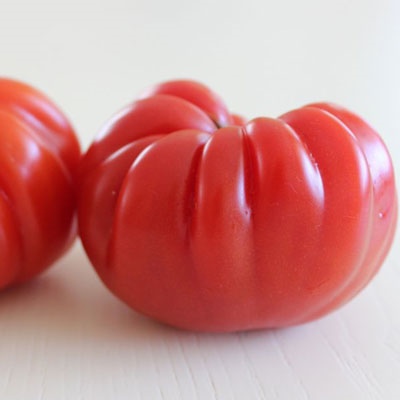
- Authors: USA
- Name synonyms: Beauty Lottringa
- Category: grade
- Growth type: indeterminate
- Appointment: fresh consumption
- Ripening period: mid-early
- Ripening time, days: 110-115
- Growing conditions: for greenhouses
- Bush size: tall
- Bush height, cm: 180-200
Lorraine Beauty Tomatoes are a popular and beloved product all over the world. But the technology of growing tomatoes is a whole range of activities that is not easy to master.
This culture is quite capricious, caring for tomatoes requires a lot of time and patience, therefore, in order to grow a rich harvest, you will have to work hard and put a lot of effort.
Description of the variety
Indeterminate varietal plant suitable for greenhouse cultivation. The bushes are tall and can reach 2 meters. The bushes are strong, the leaves are ordinary. This is not a standard plant, with fruits that are not canned, only consumed fresh.
The main qualities of the fruit
The fruits are red when ripe, large, weighing up to half a kilogram. Up to 6 of them can be formed in one brush. Special attention to the pulp, which is hollow, fleshy, but not juicy. The Lorraine beauty tomato has good keeping quality.
Taste characteristics
Tomatoes of this variety are pleasant to the taste, sweetish.
Ripening and fruiting
Lorraine beauty is a mid-early variety with long fruiting. Harvesting begins in July and ends in September.
Yield
According to this indicator, it is a medium-yielding variety.
The timing of planting seedlings and planting in the ground
In early March, you can sow seeds, in mid-May, the seedlings are transplanted into a greenhouse.

Growing tomato seedlings is an extremely important process, because it largely depends on whether the gardener can harvest at all. All aspects must be taken into account, from seedbed preparation to planting in the ground.
Landing scheme
For greenhouse cultivation, a planting scheme of 40-50 cm between bushes and 60 between rows is used.

Growing and caring
Tying and pinching this indeterminate variety is necessary in order to reduce the load on the bushes and prevent the fruits from breaking the plant. The formation of bushes is also used, while leaving from 2 to 3 stems.
Soil for tomatoes Lorraine beauty plays almost the main role in growing a high-quality crop, not only at the seedling stage, but also after the plant is transferred to a permanent place. Therefore, planting seeds should be carried out only in prepared soil, and its processing before transferring seedlings is a prerequisite.
For the preparation of seedlings, you can choose both universal vegetable and special "tomato" types of soil - the assortment in shops for gardeners is large. If you have been growing tomatoes for more than one year, you can use the soil from the greenhouse. This option is considered by many to be optimal, since the Lorraine beauty tomato is initially formed in the ground in which it will grow in the future. Often, at the stage of transplantation, seedlings die precisely because of the "conflict" of soils - "home" can be "softer and more comfortable" than greenhouse.
One way or another, and the land must be prepared in advance. First of all, this concerns the soil, it should be treated with copper sulfate, after which mineral and organic fertilizers should be applied. This is done a few days before the seed is planted. Before transferring the seedlings of the Lorraine beauty to the greenhouse, the soil must also be treated with copper sulfate.
As for sowing, it is customary to plant the seeds of the Lorraine beauty tomatoes to a depth of no more than 5 millimeters, otherwise they germinate poorly and for a long time. Planting seeds can be carried out both in separate pots and in large containers. The first option is considered more convenient and comfortable for plants.
The question of whether it is necessary to transplant seedlings from small containers into larger ones after the emergence of shoots, everyone decides for himself. If there is enough space for the Lorraine beauty tomato, there is no need to transplant (this is additional stress), but if there is not enough space for the correct formation of the root system, it is better to transplant.
Please note that Lorraine Belle tomatoes are considered a drought tolerant crop, so there is no need to water them often and a lot. Moreover, experienced gardeners are convinced that "underwatering" a tomato is better than over-watering. Unlike, for example, cucumbers, tomatoes Lorraine beauty do not like a lot of water - excess moisture "strangles" them.
But tomatoes are very fond of light and warmth. In order for the seeds to sprout, they need to create a comfortable environment. But do not rush to use heating lamps - an indicator in the range from 18 to 25 ° C is considered a comfortable growing temperature. By installing additional sources of light and heat, you can simply burn the plants.
If the soil has been previously cleaned and cultivated, it is enough to simply loosen the land and leave the seedlings to get used to the new conditions for several days. When the seedlings got stronger, and the Lorraine beauty began to develop, the bushes must be "pinched". Many pinch the stem at the stage of seedling development. The main emphasis must be placed on the removal of lateral shoots after transplantation to a permanent place of growth.




A plant needs different micronutrients at each stage of growth. All fertilizers can be divided into two groups: mineral and organic. Folk remedies are often used: iodine, yeast, bird droppings, eggshells.
It is important to observe the rate and period of feeding. This also applies to folk remedies and organic fertilizers.



























































































